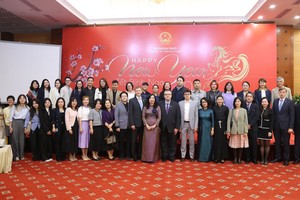
A visit to Quy Nhon maritime port in Binh Dinh Province during the skipjack and yellowfin tuna fishing season shows several concerns.
56-year-old fishing vessel owner Nguyen Nhon from Duc Pho District of Quang Ngai Province explained that despite being at the peak of the fishing season, reduced prices and poor catches have led many maritime workers to either cease operations or transition to onshore seasonal work. His ship has been fortunate to avoid losses, keeping some crew members, but still struggles with persistent labor shortages.
Similarly, numerous boat owners in Hoai Huong and Hoai Hai communes, Hoai Nhon Town, Binh Dinh are forced to provide deposits of VND5-6 million (US$197-236) per worker just to secure enough labor for offshore expeditions.
In Tho Quang fishing port, located at Son Tra District of Da Nang City, fishing vessel owner Cao Van Hoang is deeply concerned that his crew now predominantly consists of workers aged 40-55, and in some cases up to 60 years old, with virtually no younger replacements available.
Senior fisherman Nguyen Thanh Da from Quang Ngai Province commented that labor shortages make maritime expeditions increasingly challenging. Each crew member must handle multiple responsibilities, and he desperately seeks young, physically fit worker – a task akin to finding a needle in the ocean. “Most young people today seek employment onshore, such as working in companies or pursuing overseas labor opportunities. Others simply refuse extended maritime voyages,” explained Da.
61-year-old fisherman Nguyen Van Hung from Ha Tinh Province sadly recalled that previously, fishing was quite profitable, with abundant marine resources. Voyages lasting 3-5 days provided substantial income for both owners and crew. However, in the past five years, fishing grounds have become depleted, maritime channels have silted up, and risks have increased. Voyages often fail to cover basic operational costs like labor, fuel, and provisions.
Consequently, coastal residents, especially younger generations, have lost enthusiasm for maritime professions, gradually transitioning to other onshore jobs. Without a young labor force, many vessels have to opt for coastal fishing.
The shortage of seafaring labor, especially among young people, is a widespread problem across Vietnam's central coast. Many young people from coastal regions are choosing to work in factories or seek employment overseas, rather than following in their parents’ footsteps.
In Ha Tinh Province, 2,570 registered vessels support over 10,000 maritime workers, though these numbers continuously fluctuate. Visits to coastal regions revealed numerous vessels remaining docked, primarily due to workforce shortages. Those that do venture out are often crewed by elderly workers, compromising operational efficiency.
A Thua Thien-Hue Fisheries Department official highlighted not just the shortage of healthy, experienced workers, but also the lack of professionally trained personnel capable of managing large-capacity vessels, advanced fishing techniques, and long-term seafood preservation. This circumstance has reduced the performance of seafood exploitation in the Central region compared with its inherent potential and strategic advantages.
Deputy Director Phan Van My of the Department of Agriculture and Rural Development in Da Nang City shared that in the current labor scarcity landscape, reorganizing team models to develop appropriate fishing strategies to expedite vessels' return to the open sea is imperative.
The nation is comprehensively restructuring the fisheries sector, prioritizing balanced and sustainable extraction methodologies. Locally, this involves accelerating fleet restructuring by progressively phasing out obsolete, inefficient vessels and methodically establishing professional fishing teams.
In the long term, addressing the maritime labor drought necessitates a comprehensive strategy and vision – not merely confined to the Central Region but extending nationwide. The State should promptly implement appropriate policies, such as vessel retrofitting, upgrading fishing fleets, organizing professional skill enhancement training for maritime workers, with particular emphasis on youth recruitment.
This includes transitioning and expanding successful offshore operational models, intensifying investment in technological transfer, and applying scientific and mechanical innovations to maritime extraction activities to optimize cost efficiency, reduce labor requirements, and enhance the productivity of each maritime expedition.
Moreover, vessel owners must prioritize improving workplace and living conditions aboard vessels, ensuring safety and convenience to maintain fishermen's health and professional commitment.
Director Nguyen Quang Vinh Binh of the Fisheries Department of Thua Thien-Hue Province reveals preliminary statistical insights, indicating that merely 0.1 percent of Vietnam's maritime workforce has received formal education through universities, colleges, and specialized secondary schools. The majority continue to rely predominantly on experiential knowledge transferred intergenerationally.
This represents a substantial impediment to the industrialization and modernization of maritime professions, posing a significant threat to the developmental route of the marine fishing sector. Notably, most universities and colleges in the Central Region currently lack dedicated maritime vocational training programs.
























